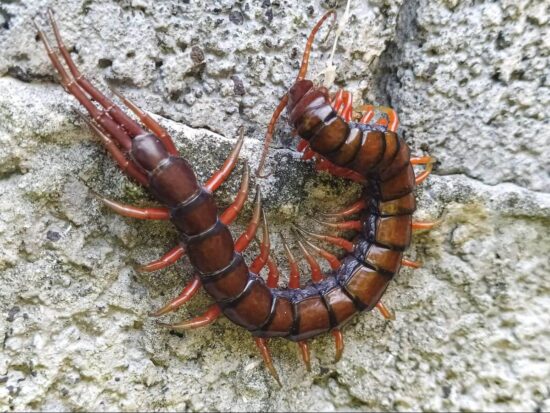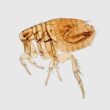Nobody wants to see a many-legged creature scurrying across their bathroom floor at 2 AM. Yet house centipedes are one of the most common uninvited guests homeowners face. These ancient arthropods have been around for 430 million years, living everywhere from tropical rainforests to dry deserts.
The house centipede is the most common type found in homes. Originally from the Mediterranean region, these creatures have spread around the world by hitching rides with humans. Understanding what attracts centipedes and where centipedes come from can help you keep them out of your living space for good.
The key to preventing centipede problems is knowing what they need to survive: moisture, food, and shelter. When your home provides these three things, you’re basically rolling out the welcome mat for these unwanted guests.
1. Moisture and High Humidity Are Centipede Magnets
High humidity levels are like a neon sign that attracts centipedes to your home. Unlike insects that have a waxy coating to keep moisture in, centipedes dry out quickly without enough humidity around them. This makes them constantly search for damp areas where they can survive.
- Pre-scented sticky traps for spiders, roaches, crickets & more
- Long-lasting, pet-safe, non-toxic formula with no odor
- Foldable design protects glue from dust and keeps traps hidden
- Made in the USA for year-round indoor pest control
Water leaks are one of the biggest problems that bring centipedes indoors. A dripping faucet under your kitchen sink or a small pipe leak in your basement creates the perfect environment for these creatures. They’re also drawn to homes with poor air circulation in bathrooms, basements, and closets where moisture builds up over time.
Broken or clogged gutters cause another major moisture issue. When water can’t flow properly through your gutters, it spills over and pools around your home’s foundation. This creates the exact damp conditions where centipedes come from in nature.
Centipedes simply cannot survive in dry conditions. If your home has humidity problems, you’re giving them exactly what they need to set up camp and start reproducing.
2. They Follow Their Food Source Into Your Home
What attracts centipedes more than anything else is a steady supply of prey. These creatures are hunters that feed on other bugs, so they go wherever the hunting is good. If your home has cockroaches, spiders, silverfish, or carpet beetles, centipedes will eventually show up to eat them.
Centipedes also love munching on bed bugs, crickets, moths, earwigs, ants, and termites. Basically, if you have any kind of bug problem, you’re creating a buffet that will draw centipedes inside. They’re like the cleanup crew of the pest world.
The tricky thing is that many homeowners don’t even realize they have other bug problems until they start seeing centipedes. These hunters are really good at finding hidden insect populations that people miss. So when centipedes appear, it often means there’s a bigger pest issue that needs attention.
This is actually where centipedes come from when they enter homes. They start outside hunting in your yard, but when they find more prey inside your house, they decide to stick around for the easy meals.
3. Dark and Quiet Hiding Spots Are Perfect Centipede Hotels
Centipedes love places where they won’t be bothered during the day. They’re nocturnal, which means they sleep during daylight hours and hunt at night. This makes cluttered areas like basements, attics, and storage rooms very appealing to them.
Piles of boxes, bags, and other stored items create ideal hiding spots. Centipedes can squeeze into surprisingly small spaces because their bodies are flat and flexible. They also like hanging out behind appliances, under sinks, and in floor drains where people rarely look.
Cement block walls are another favorite hiding place because they often have small cracks and crevices. These spaces stay dark and humid, giving centipedes everything they need during their resting hours.
Areas that rarely get disturbed by human activity are especially attractive. If you have a corner of your basement where you never go, or a closet that stays closed most of the time, these spots become prime real estate for centipedes looking for a permanent home.
4. Temperature Changes Drive Centipedes Indoors
Seasonal weather changes are a major factor in understanding where centipedes come from when they appear in homes. These creatures are very sensitive to temperature swings and will move indoors when outdoor conditions become uncomfortable.
Winter is the biggest problem for centipede invasions. House centipedes cannot survive freezing temperatures outside, so they actively look for warm indoor spaces when the weather gets cold. Your heated home becomes a cozy winter shelter where they can stay active and hunt for food.
Summer heat waves and drought conditions can also drive centipedes inside. When it gets too hot and dry outside, they need to find more humid environments to survive. Air-conditioned homes often have the right temperature and moisture levels to keep centipedes happy.
Spring and fall are the most active seasons for centipede movement. During spring, centipedes are coming out of their winter hiding spots and looking for new territory. Fall brings the opposite problem as they start seeking winter shelter before the cold hits.
This seasonal pattern explains why many homeowners suddenly see centipedes during certain times of year, even when they haven’t had problems before.
5. Outdoor Lighting Creates Hunting Opportunities
While bright lights don’t directly attract centipedes, they do create perfect hunting conditions that bring these predators closer to your home. Outdoor lighting draws flying insects like moths, flies, and mosquitoes, which then become easy prey for hungry centipedes.
Standard white lights and bright bulbs are especially good at attracting flying bugs. When insects gather around your porch lights, deck lighting, or security lights, centipedes learn that these areas are reliable food sources. They’ll start spending more time near your home’s exterior, which increases the chances they’ll find a way inside.
Light that spills out from windows also contributes to this problem. If you leave curtains open at night with indoor lights on, you’re basically advertising to every bug in the neighborhood. More bugs outside means more food that attracts centipedes to your property.
The interesting thing is that centipedes themselves actually avoid bright lights because they’re sensitive to both light and heat. But they’re smart enough to hunt in areas where their prey gathers, even if it means getting closer to light sources than they’d normally prefer.
6. Your Yard and Landscaping Provide Perfect Breeding Grounds
- Pre-scented sticky traps for spiders, roaches, crickets & more
- Long-lasting, pet-safe, non-toxic formula with no odor
- Foldable design protects glue from dust and keeps traps hidden
- Made in the USA for year-round indoor pest control
Understanding where centipedes come from starts with looking at your outdoor spaces. Thick layers of mulch around your home’s foundation create ideal centipede habitat because mulch stays moist and provides plenty of hiding spots.
Piles of leaves, grass clippings, and other organic debris are like luxury apartments for centipedes. These areas stay damp, dark, and undisturbed, giving centipedes everything they need to live and reproduce. The more yard waste you have piled up, the larger your local centipede population will grow.
Firewood stacks are another major problem, especially when wood is stored directly on the ground. Rotting logs and damp wood provide both shelter and prey for centipedes. They love living under bark and in the small spaces between logs.
Decorative landscape features like rocks, bricks, and stone borders also create centipede hiding spots. Any object that sits on your grass and blocks sunlight creates a damp microenvironment underneath where centipedes can thrive.
Overgrown vegetation near your home makes the problem worse by creating more shaded, humid areas. When bushes and plants grow right up against your exterior walls, they trap moisture and create highways for centipedes to reach your foundation.
7. Easy Entry Points Welcome Centipedes Inside
What attracts centipedes to actually enter your home are the many small openings that most homeowners don’t even notice. Cracks in your foundation, exterior walls, and around windows create perfect entry routes for these flat-bodied creatures.
Gaps around doors and windows are common problem areas. Even tiny spaces under doors or around window frames can let centipedes squeeze inside. Their flexible bodies allow them to fit through surprisingly narrow openings.
Floor drains and poorly fitted baseboards also provide easy access. Centipedes can crawl up through drain pipes or slip behind loose baseboards to get inside your walls. Once they’re in your wall spaces, they can pop out anywhere in your home.
Utility penetrations where pipes, cables, or wires enter your home often have gaps that aren’t properly sealed. These openings might be small, but they’re like superhighways for centipedes and other pests trying to get inside.
The key point is that centipedes don’t need large openings to invade your home. They’re excellent at finding and using even the smallest entry points that homeowners often overlook during routine maintenance.
8. Poor Sanitation Creates Bug Buffets
Waste management problems indirectly attract centipedes by creating conditions that support large insect populations. When your outdoor trash cans don’t have tight-fitting lids, they become breeding grounds for flies and other bugs that centipedes love to eat.
Decomposing organic matter anywhere on your property will draw insects, which in turn brings centipedes. This includes compost piles that aren’t properly maintained, pet waste that isn’t cleaned up regularly, and fallen fruit from trees that’s left to rot.
Standing water from poor drainage creates mosquito breeding sites and attracts other water-loving insects. Centipedes follow these food sources and often end up much closer to your home than they would be otherwise.
Areas where garbage odors can escape are especially problematic because they attract flies from long distances. The more flies you have buzzing around your property, the more likely centipedes will show up to hunt them.
Good sanitation practices don’t just prevent centipedes directly. They also control the insect populations that centipedes depend on for food, making your entire property less attractive to these predators.
9. Indoor Climate Problems Make Homes More Appealing
Climate control issues inside your home can make it more attractive to centipedes looking for the perfect living environment. Inconsistent heating that creates warm and cool zones gives centipedes options to find their preferred temperature.
Poor insulation allows temperature fluctuations that can actually attract centipedes during extreme weather. If your basement stays cool in summer while upstairs gets hot, centipedes might move in to take advantage of the comfortable lower level.
Inadequate dehumidification in basements and bathrooms creates the high humidity conditions that centipedes need to survive. Without proper moisture control, these areas become perfect centipede habitats inside your home.
Steam buildup from showers, cooking, and laundry without proper ventilation adds to humidity problems. When moist air can’t escape, it creates the damp conditions where centipedes come from in their natural outdoor habitats.
House centipedes have actually evolved to live in human dwellings and can complete their entire life cycle indoors when conditions are right. This makes climate control one of the most important factors in preventing long-term centipede problems.
10. Accidental Transportation Brings Surprise Guests
Sometimes centipedes enter homes by hitchhiking on items that people bring inside. Firewood is one of the biggest culprits because it’s often stored outside in damp conditions where centipedes like to hide. When you bring logs indoors for your fireplace, you might be bringing centipedes along for the ride.
Used furniture that’s been stored in garages, basements, or outdoor areas can harbor centipedes in hidden spaces. Before bringing any secondhand furniture inside, it’s smart to inspect it carefully for signs of pest activity.
Seasonal decorations like Christmas trees create another opportunity for accidental centipede transportation. Trees that have been sitting in outdoor lots can pick up centipedes and other pests that then get carried right into your living room.
Camping equipment that’s been stored in damp outdoor locations often becomes temporary housing for various pests. Tents, sleeping bags, and other gear should be thoroughly checked and cleaned before being brought back inside.
Potted plants that move between indoor and outdoor spaces can also transport centipedes. These creatures sometimes hide in soil or among plant roots, making them nearly impossible to spot during casual inspection.
Keep Centipedes Out for Good
Now that you understand what attracts centipedes and where centipedes come from, preventing them becomes much easier. The key is controlling the three main things they need: moisture, food, and shelter.
Start by fixing any water leaks and improving ventilation in damp areas of your home. Use dehumidifiers in basements and bathrooms to keep humidity levels low. Make sure your gutters work properly and direct water away from your foundation.
Control other pest problems to eliminate the food sources that attract centipedes in the first place. Regular pest control treatments can prevent the insect populations that centipedes depend on for survival.
Seal up entry points around your home and keep outdoor areas clean and free of debris. Remove piles of leaves, trim vegetation away from your exterior walls, and store firewood off the ground and away from your house.
Remember that centipedes are actually beneficial predators that help control other pest problems. But when they become too numerous or start appearing inside your home regularly, it’s usually a sign that you need to address underlying moisture or pest issues. Taking care of these root causes will solve your centipede problem naturally while making your home healthier and more comfortable overall.



